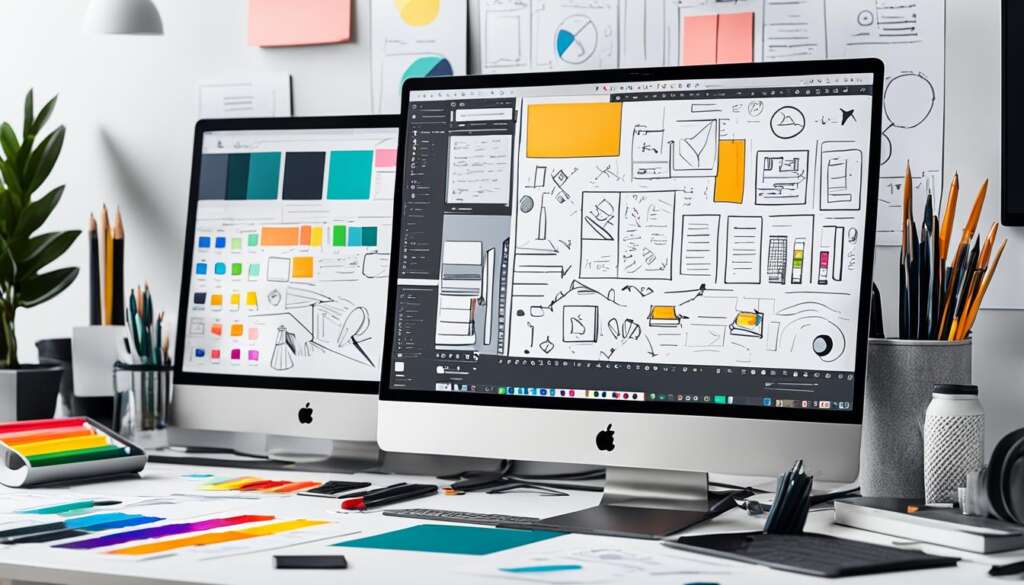Table of Contents
Welcome to our comprehensive comparative review of UI/UX design tools! In this article, we will be exploring the best UI/UX design tools and comparing them based on their effectiveness in various design tasks. We will be focusing on three popular tools: Sketch, Figma, and Axure. These tools have generated loyal followings in the UX design community and excel at specific jobs within the design workflow.
Our goal is to assess their performance in tasks such as concept ideation, creating low-fidelity and high-fidelity deliverables, creating interactive prototypes, creating design systems, and delivering to development. By the end of this review, you’ll have a clear understanding of the strengths and weaknesses of each tool and be able to choose the one that best suits your design needs.
So, whether you’re a seasoned UI/UX designer or just starting your journey, join us as we dive deep into these UI/UX design tools and help you make an informed decision to take your designs to the next level.
Stay tuned for subsequent sections where we’ll conduct a task-based review, evaluate their performance in concept ideation, creating low-fidelity and high-fidelity deliverables, creating interactive prototypes, building design systems, and delivering to development. We’re excited to share our findings with you!
Task-Based Review
In this section, we will be conducting a task-based review of the three UI/UX design tools: Sketch, Figma, and Axure. Each tool will be evaluated based on its performance in various design tasks, including concept ideation, creating low-fidelity deliverables, creating high-fidelity deliverables, creating interactive prototypes, creating design systems, and delivering to development.
You will get an in-depth analysis of each tool’s capabilities and understand how well they perform in different design tasks.
- Concept Ideation: We will assess how Sketch, Figma, and Axure support concept ideation, including collaboration features, ease of use, and fostering creativity among interdisciplinary teams.
- Creating Low-fidelity Deliverables: We will compare the ability of Sketch, Figma, and Axure to create low-fidelity wireframes, considering factors such as ease of use, speed of delivery, and modification capabilities.
- Creating High-fidelity Deliverables: The performance of Sketch, Figma, and Axure in creating high-fidelity deliverables, such as mockups with color and visual detail, will be examined. We will evaluate their editing capabilities, support for object fills and strokes, and ease of exporting designs into different file formats.
- Creating Interactive Prototypes: We will compare Sketch, Figma, and Axure based on their support for creating interactive prototypes. Navigational capabilities, menu functionality, and transitions will be assessed.
- Building Design Systems and Delivering to Development: The support offered by Sketch, Figma, and Axure for the creation of design systems and seamless collaboration with developers will be evaluated. Component libraries, support for responsive design, integration with other tools, and ease of communication will be considered.
By the end of this section, you will have a comprehensive understanding of each tool’s strengths and weaknesses in different design tasks, enabling you to make an informed decision on which tool is the most suitable for your UI/UX design needs.
Doing Concept Ideation
Concept ideation plays a vital role in the UI/UX design process as it involves generating fresh ideas and exploring innovative solutions. In this section, we will examine how Sketch, Figma, and Axure support concept ideation and foster creativity within interdisciplinary teams.
Collaboration Features:
When it comes to collaboration, Sketch offers plugins and integrations that enable designers to work seamlessly with other team members. Figma, on the other hand, takes collaboration to the next level by allowing real-time editing and commenting directly on the designs. Axure provides features for sharing and reviewing designs, making it easier to gather feedback from stakeholders and iterate on concepts.
Ease of Use:
Sketch, Figma, and Axure are known for their user-friendly interfaces and intuitive design tools. Sketch offers a wide range of built-in design elements and templates, making it easy to quickly create and iterate on concepts. Figma’s cloud-based platform allows for easy access and collaboration, with a shallow learning curve. Axure provides a comprehensive set of tools for designing interactions and complex prototypes, although it may require a bit more time to master.
Fostering Creativity:
Sketch provides a versatile canvas where designers can freely explore different design directions and experiment with various visual elements. Figma’s collaborative nature encourages designers to iterate and build upon each other’s ideas, fostering a creative and dynamic environment. Axure offers powerful prototyping capabilities, allowing designers to bring their concepts to life and test different interactions, stimulating creativity.
Based on our evaluation, all three tools are well-equipped for concept ideation. However, the choice ultimately depends on the specific needs of your design team and the level of collaboration required. Consider the strengths and weaknesses of each tool in terms of collaboration features, ease of use, and fostering creativity to determine the most suitable tool for your concept ideation process.
Continue reading to discover how Sketch, Figma, and Axure perform in creating low-fidelity deliverables.
Creating Low-fidelity Deliverables
Creating low-fidelity deliverables, such as wireframes, is a crucial step in UI/UX design. Low-fidelity wireframes provide a simplified visual representation of the design concept, allowing designers to focus on layout and functionality without getting bogged down by details. In this section, we will compare three popular UI/UX design tools – Sketch, Figma, and Axure – in terms of their ability to create low-fidelity deliverables.
When it comes to ease of use, Sketch offers a user-friendly interface that makes it easy to quickly draft low-fidelity wireframes. Its intuitive tools and drag-and-drop functionality allow designers to create wireframes without any steep learning curves.
Figma, on the other hand, excels in collaboration. With its cloud-based platform, multiple designers can work simultaneously on the same wireframe, making it ideal for team projects. The real-time collaboration features of Figma ensure seamless communication and reduce iteration time.
Axure is known for its extensive prototyping capabilities, which can be beneficial when creating low-fidelity wireframes. Its advanced interactions and animations allow designers to simulate user interactions and test the usability of the wireframes before moving forward.
Speed of delivery is another important factor to consider when creating low-fidelity deliverables. Sketch’s lightweight file size and efficient rendering make it a fast option for generating wireframes. Figma’s cloud-based nature enables instant sharing and access to wireframes, making it convenient for design teams. Axure’s robust prototyping features may require more time investment but can result in highly interactive and functional wireframes.
Modification capabilities are essential when working with low-fidelity wireframes, as design iterations and feedback are common in the early stages of the design process. Sketch offers a wide range of plugins that extend its functionality and allow for easy modification of wireframes. Figma’s flexible layout system and shared components enhance the modification process for design teams. Axure’s dynamic panels and adaptive views enable dynamic content, making it easier to modify and update wireframes.
Overall, when it comes to creating low-fidelity deliverables, choosing the right tool depends on your specific needs. Sketch provides a simple and intuitive interface, perfect for individual designers. Figma offers collaborative features, making it ideal for team projects. Axure’s advanced prototyping capabilities excel in creating highly interactive wireframes. Assessing the ease of use, speed of delivery, and modification capabilities of each tool will help you determine the best option for your design workflow.
Creating High-fidelity Deliverables
High-fidelity deliverables play a crucial role in showcasing designs to clients and stakeholders. These deliverables, which include mockups with vibrant colors and intricate visual details, allow for a more comprehensive understanding of the final product.
In this section, we will thoroughly analyze how Sketch, Figma, and Axure perform in terms of creating high-fidelity deliverables. By evaluating their editing capabilities, support for object fills and strokes, and ease of exporting designs into various file formats, we will help you determine the most effective tool for this task.
Firstly, let’s examine the editing capabilities of each tool. Sketch provides an intuitive interface with an array of powerful design features. Its flexible editing options allow designers to easily fine-tune every aspect of their high-fidelity deliverables. Figma, on the other hand, offers real-time collaboration, making it ideal for remote teams working on high-fidelity designs. Axure, known for its robust prototyping capabilities, offers advanced interactions and animations for creating highly realistic high-fidelity deliverables.
Next, we will explore the support for object fills and strokes. In Sketch, designers have extensive control over object properties, including gradients, shadows, and borders. Figma provides similar capabilities, allowing designers to apply dynamic effects and styles to objects. Axure offers a rich library of predefined styles, enabling easy customization and consistency in high-fidelity deliverables.
Lastly, we will consider the ease of exporting designs into different file formats. Sketch allows designers to export their high-fidelity deliverables in various formats, such as PNG, JPG, and PDF. Figma offers seamless exporting with options for different resolutions and formats. Axure supports exporting to HTML, CSS, and JavaScript, providing designers with interactive high-fidelity deliverables.
By thoroughly comparing Sketch, Figma, and Axure in terms of their editing capabilities, support for object fills and strokes, and ease of exporting designs, you will gain a clear understanding of which tool is most effective for creating high-fidelity deliverables.
| Tool | Editing Capabilities | Support for Object Fills and Strokes | Exporting Options |
|---|---|---|---|
| Sketch | Intuitive interface with powerful editing features | Extensive control over object properties | Export to PNG, JPG, PDF, and more |
| Figma | Real-time collaboration and dynamic editing | Flexible object effects and styles | Seamless export with different resolutions and formats |
| Axure | Robust prototyping capabilities | Rich library of predefined styles | Export to HTML, CSS, JavaScript, and more |
Creating Interactive Prototypes
When it comes to UI/UX design, interactive prototypes play a vital role in testing and demonstrating the functionality of a design. They provide a hands-on experience for users, allowing them to interact with the design before it is fully developed. In this section, we will compare three popular design tools – Sketch, Figma, and Axure – in terms of their support for creating interactive prototypes.
Navigation:
Efficient navigation is key to a seamless user experience. Let’s see how Sketch, Figma, and Axure handle navigation in interactive prototypes. Sketch offers a variety of plugins and libraries that facilitate the creation of interactive navigation elements. Figma, with its intuitive interface, allows designers to easily define navigation flows using clickable hotspots. Axure, on the other hand, provides a robust set of interactions and dynamic panels to create complex navigation experiences.
Menu Functionality:
A smooth and intuitive menu is essential for guiding users through the various sections of a design. Sketch offers plugins and prebuilt UI kits for creating menu functionality, enabling designers to quickly prototype menu interactions. Figma’s versatile components make it easy to design and customize menus that suit the project’s needs. Axure’s rich feature set allows for the creation of intricate menu systems, complete with dropdowns, flyouts, and other interactive elements.
Transitions:
Transitions add polish and realism to interactive prototypes, enriching the user experience. With Sketch, designers can use plugins and libraries to create smooth transitions between different screens or artboards. Figma offers a wide range of transition options, allowing designers to create sleek and professional animations. Axure enables designers to create complex and interactive transitions, making it a powerful tool for prototyping dynamic user experiences.
By evaluating the capabilities of Sketch, Figma, and Axure in terms of navigation, menu functionality, and transitions, you can determine which tool best meets your requirements for creating interactive prototypes. Each tool brings its own unique set of features and strengths to the table, so consider your project needs and design preferences when making your choice.
Building Design Systems and Delivering to Development
Design systems play a vital role in creating consistent and cohesive user experiences. They provide a framework for designers and developers to collaborate efficiently and ensure visual and functional harmony across digital products. In this section, we will explore how Sketch, Figma, and Axure support the creation and maintenance of design systems.
When it comes to building design systems, Sketch offers an extensive range of features. With its powerful symbol and library functionality, designers can create reusable components and maintain a centralized repository of design elements. Figma, on the other hand, provides robust collaboration tools that enable designers and developers to work seamlessly together. Its intuitive component system ensures consistency throughout the design process.
Axure, known for its prototyping capabilities, also offers features for building design systems. Its widget libraries allow designers to define and reuse custom components, promoting consistency across different projects. Additionally, Axure’s ability to generate CSS stylesheets and HTML documentation aids in delivering design assets to developers.
When evaluating these tools for delivering designs to development teams, it is important to consider their support for responsive design and integration with other software. While Sketch and Figma excel in their ability to adapt designs to different screen sizes and devices, Axure provides comprehensive documentation for developers to understand the design intent.
In conclusion, when it comes to building design systems and delivering design files to development, Sketch, Figma, and Axure each have their strengths. Sketch’s emphasis on symbols and libraries makes it a go-to choice for designers seeking a flexible and robust system. Figma’s collaborative features foster seamless communication between designers and developers, while Axure’s prototyping capabilities and comprehensive documentation cater to a different set of needs. Choose the tool that aligns best with your team’s requirements and workflow for optimal efficiency and collaboration.
FAQ
What is UI/UX design?
UI/UX design refers to the process of creating user interfaces and experiences for digital products or services. It involves creating visually appealing and user-friendly designs that enhance the overall user experience.
What are UI/UX design tools?
UI/UX design tools are software applications or platforms that designers use to create and prototype user interfaces and experiences. These tools provide features and functionalities that help designers streamline their design process and collaborate effectively with their teams.
What is a task-based review of UI/UX design tools?
A task-based review of UI/UX design tools involves evaluating the performance of different tools based on their capabilities in various design tasks. It assesses how well each tool supports concept ideation, creating low-fidelity deliverables, creating high-fidelity deliverables, creating interactive prototypes, building design systems, and delivering designs to development.
What is concept ideation in UI/UX design?
Concept ideation is the process of generating new ideas and concepts for a design. It involves brainstorming and exploring different possibilities to solve a design problem. Concept ideation helps designers come up with innovative and creative solutions.
What are low-fidelity deliverables in UI/UX design?
Low-fidelity deliverables in UI/UX design are rough and minimalistic representations of a design. They often include wireframes or sketches that focus on the structure and functionality of the design rather than visual details. Low-fidelity deliverables help in quickly communicating design concepts and ideas.
What are high-fidelity deliverables in UI/UX design?
High-fidelity deliverables in UI/UX design are detailed and polished representations of a design. They include mockups with colors, visual details, and sometimes animations. High-fidelity deliverables provide a realistic preview of the final design and are used for presentations to clients and stakeholders.
What are interactive prototypes in UI/UX design?
Interactive prototypes in UI/UX design are functional and clickable representations of a design. They simulate the user journey and allow users to interact with the design as they would with the final product. Interactive prototypes are used for user testing and showcasing design functionality.
What are design systems in UI/UX design?
Design systems in UI/UX design are a collection of reusable design components, guidelines, and assets that ensure visual consistency and efficiency in the design process. They help maintain a cohesive and scalable design language across different projects and ensure a seamless handoff to development.
How do UI/UX design tools facilitate collaboration with developers?
UI/UX design tools provide features that support collaboration with developers. They often include features like design handoff, code generation, and integration with developer-friendly platforms. These features help designers and developers communicate effectively and ensure accurate implementation of designs.













